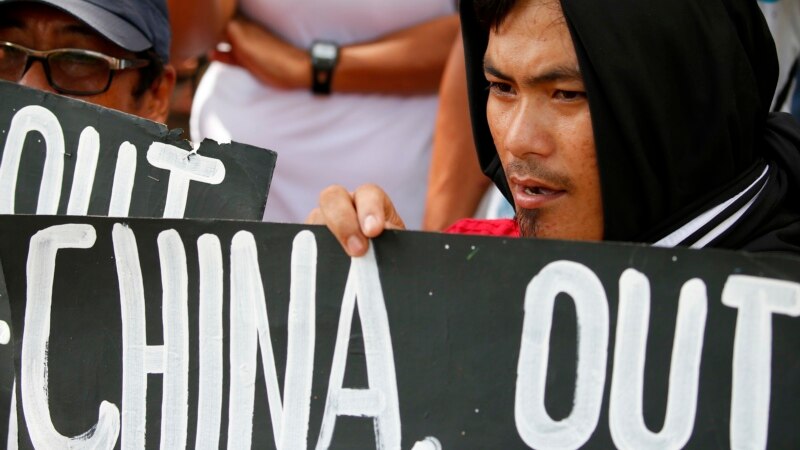Chinese Charm in Southeast Asia Shows Signs of Chafing

China’s use of economic aid to placate angry neighbors is still seen as effective in allowing it to consolidate its controversial claims in the South China Sea, but it is also showing early signs of wearing thin a year after an international court rejected Beijing's legal basis for maritime claims that have put it at odds with much of Southeast Asia.
At the request of the Philippines, a world court arbitration tribunal in The Hague ruled in July 2016 that Beijing was violating other countries’ exclusive economic zones in the South China Sea.
China has used ‘aid as sweetener’ in South China Sea dispute
Beijing rejected the decision but since then has stepped up aid and investment to four Southeast Asian countries. Those states resent China for building artificial islets for military use and passing coast guard ships in contested tracts of the sea -- before as well as after the ruling. Analysts say China hopes that aid will deter other countries from filing another case in The Hague.
“Even China is being careful in order to avoid a second case from being filed,†said Jay Batongbacal, director of the Institute for Maritime Affairs and Law of the Sea at the University of the Philippines. “It’s forced to try to really increase economic ties.â€
China says historical usage going back 2,000 years shows it owns most of the 3.5 million-square-kilometer tropical sea, which it demarcates with a nine-dash line extending in a net-like loop from its southern coast to the island of Borneo. That claim overlaps exclusive economic zones established by Brunei, Malaysia, Vietnam and the Philippines.
A year ago the Permanent Court of Arbitration ruled that China’s “claim to historic rights to the living and non-living resources within the ‘nine-dash line’ is incompatible†with the U.N. Convention on the Law of the Sea. The convention “leaves no space for an assertion of historic rights,†it said.
In the year since the arbitration ruling, China has pledged $24 billion in aid and investment to the relatively poor Philippines, where President Rodrigo Duterte shifted to a pro-Chinese foreign policy after taking office last year. His predecessor had filed for the arbitration.
China does not want another arbitration case
China has steadily become the top investor and trading partner for Malaysia. Brunei was already in line for a Chinese seaport joint venture. Last year China stepped up talks with Vietnam about maritime cooperation and became the country’s top source of inbound tourism.
It’s costing China more to “keep other countries happy†in exchange for not filing another arbitration case, Batongbacal said. But the largess shows no sign of stopping -- nor does China's construction of artificial islands for military use.
“It is likely that the regional grouping (of Southeast Asian countries) will maintain a cautious approach in its relations with China and that any statements or agreements will be watered down so as to avoid upsetting Beijing,†said Jonathan Spangler, director of the South China Sea Think Tank in Taipei.
“Chinese policymakers know that now is as good a time as any to push forward with securitization of their maritime territorial claims," he said.
Eye on larger nations
China hopes its engagement with Southeast Asian nations will make bigger countries, such as India and Japan, see China positively rather than as a country that flouts world court decisions, said Yun Sun, East Asia Program senior associate at the Stimson Center think tank in Washington. Otherwise, she said, its international leadership image will suffer.
“They care because, although their economic strength is so massive and they can coerce any country that does not agree with China, they also understand that this doesn’t mean that other countries respect them for it or they genuinely accept China’s leadership for it,†Sun said.
Holes in China's strategy
But some experts warn of increasingly obvious flaws in the Chinese formula of aid in exchange for other countries keeping quiet about their own claims to the sea that's prized for fisheries, fossil fuel reserves and shipping lanes.
They particularly cite simmering discontent in Vietnam â€" the two sides battled each other in 1974 and rammed boats in 2014 â€" and a possibly more aggressive role by the United States.
Vietnam angered China last month with exploration for oil in a sea block it feels is disputed while Hanoi says it’s Vietnamese, said Le Hong Hiep, research fellow with ISEAS Yusof Ishak Institute in Singapore. Vietnam’s move prompted a Chinese military official to cut short a formal visit to Vietnam, China observers believe.
“After the ruling last year by the arbitral tribunal, China does not have any legitimate claim over that area,†Le said. “China insists that it’s still a disputed area and it believes that Vietnam is violating a common understanding between the leaderships of the two countries.â€
U.S. and India taking advantage
The Vietnamese foreign minister asked India this month for a stepped-up partnership agreement that includes naval boat production.
The United States riled China under former president Barack Obama by helping the armed forces of Vietnam and the Philippines.
U.S. President Donald Trump initially took a step back to work with China on containing North Korea’s ballistic missile ambitions. But since late May his government has passed two naval vessels through the South China Sea to highlight Washington’s call for freedom of navigation in the disputed waters.

0 Response to "Chinese Charm in Southeast Asia Shows Signs of Chafing"
Posting Komentar